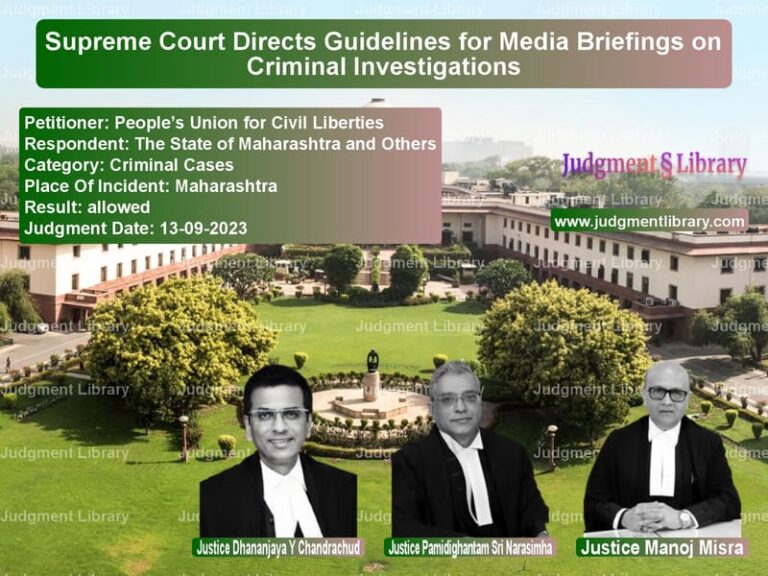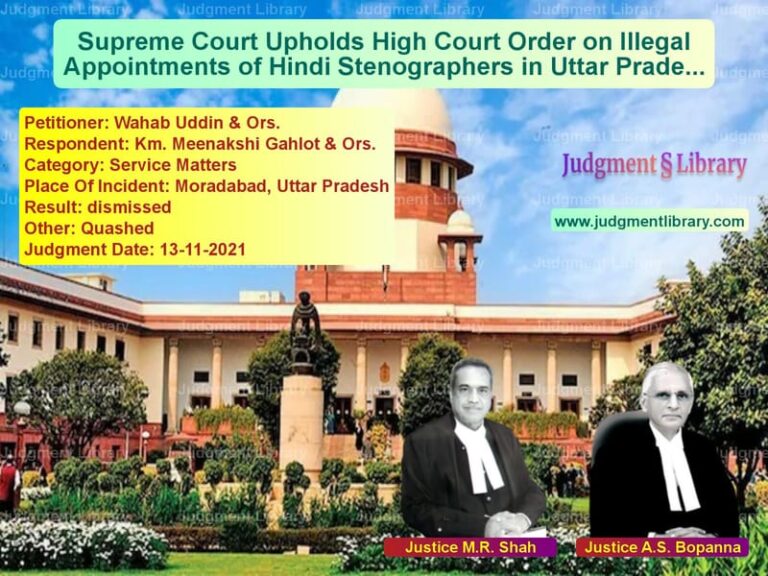Supreme Court Acquits Accused in Kanpur Riot Case Due to Flaws in Investigation
The case of State of Uttar Pradesh v. Wasif Haider & Others pertains to an appeal filed by the Uttar Pradesh government against the acquittal of several accused individuals in a criminal case related to the Kanpur riots of 2001. The Supreme Court upheld the acquittal, emphasizing that the prosecution had failed to prove the case beyond a reasonable doubt due to serious flaws in the investigation.
Background of the Case
The case originated from a riot that took place in Kanpur on March 16, 2001, where a mob of 200-300 rioters allegedly attacked a temple, engaged in looting, and set properties on fire. The police, along with the Additional District Magistrate (ADM) Chandra Prakash Pathak, responded to the scene. The prosecution claimed that rioters fired upon the police, injuring the ADM and his orderly, Ram Chandra. The ADM later succumbed to his injuries.
A case was registered under Sections 302 (murder), 307 (attempt to murder), 148 (rioting armed with a deadly weapon), and Section 7 of the Criminal Law Amendment Act, 1932, along with charges under the Arms Act and Explosive Substances Act.
Prosecution’s Case
The prosecution relied primarily on the testimony of police officers and the results of a Test Identification Parade (TIP). The key elements of the prosecution’s argument were:
- The accused were identified by witnesses in the Test Identification Parade (TIP) and in court.
- The police recovered a bullet from the ashes of the deceased, which allegedly matched a weapon possessed by one of the accused.
- The accused were responsible for firing at the police, leading to the death of ADM Chandra Prakash Pathak.
Defense’s Arguments
The defense strongly contested the prosecution’s claims, pointing out multiple inconsistencies in the investigation:
- There was a significant delay of 55 days in conducting the TIP, making the identification process unreliable.
- The accused were not kept under concealment (baparda) during this period, raising doubts about the authenticity of their identification.
- The prosecution failed to explain the delay in recording witness statements.
- The bullet allegedly recovered from the ashes of the deceased was inconsistent with the post-mortem report, which indicated an exit wound, meaning the bullet had already left the body.
- There were contradictions in the forensic evidence regarding the type of firearm recovered from the accused.
- The place of occurrence was inconsistently recorded in different investigation reports.
- Ram Chandra, the deceased’s orderly, was an eyewitness but was never examined by the prosecution.
High Court’s Judgment
The High Court, after reviewing the evidence, found serious deficiencies in the prosecution’s case and acquitted the accused. It observed:
- The Test Identification Parade was “too good to be believed,” suggesting witness tampering.
- The bullet recovery contradicted the medical reports and forensic findings.
- There was no independent witness testimony corroborating the prosecution’s claims.
- The investigative lapses created a reasonable doubt in favor of the accused.
Supreme Court’s Observations
The Supreme Court reaffirmed the High Court’s findings and emphasized key legal principles:
1. Standard of Proof in Criminal Cases
The Court reiterated that:
“A suspicion, however grave, cannot take the place of proof. The prosecution must establish its case beyond a reasonable doubt.”
The Court cited Narendra Singh v. State of Madhya Pradesh (2004) 10 SCC 699 to support this principle.
2. Importance of Proper Investigation
The Court noted that the investigation was flawed due to:
- Delay in conducting the Test Identification Parade.
- Failure to keep the accused concealed before identification.
- Contradictions in forensic reports and ballistic evidence.
- Failure to examine key witnesses like Ram Chandra.
3. Need for Independent Witnesses
The Court emphasized that reliance solely on police witnesses without independent corroboration weakened the prosecution’s case.
4. Judicial Precedents on Acquittals
The Court cited Kailash Gour & Ors. v. State of Assam (2012) 2 SCC 34:
“There can only be one set of rules and standards when it comes to trials and judgment in criminal cases.”
Acquittals should not be interfered with unless there is compelling evidence to prove that the judgment was perverse.
Supreme Court’s Judgment
The Supreme Court dismissed the appeal and upheld the High Court’s acquittal of the accused. The key points in its ruling were:
- The prosecution failed to establish a link between the accused and the crime.
- The Test Identification Parade was unreliable due to delays and exposure of the accused.
- The forensic evidence was contradictory and did not prove guilt beyond a reasonable doubt.
- The investigation was inefficient, leading to a lack of concrete evidence.
- The benefit of doubt must go to the accused.
Impact of the Judgment
The ruling sets an important precedent in criminal jurisprudence:
- Strengthening Legal Safeguards: Ensures that accused individuals are not convicted based on unreliable identification procedures.
- Need for Investigation Reforms: Highlights deficiencies in police investigations and the need for procedural discipline.
- Judicial Consistency: Reinforces the principle that acquittals should not be overturned unless there is substantial evidence of error.
- Prosecutorial Accountability: Emphasizes the role of prosecutors in ensuring fair trials based on solid evidence.
Conclusion
The Supreme Court’s ruling in State of Uttar Pradesh v. Wasif Haider & Others underscores the importance of rigorous investigation and adherence to due process in criminal trials. By upholding the acquittal, the Court reaffirmed the principle that an accused cannot be convicted based on suspicion and that a flawed investigation cannot substitute for solid evidence. This judgment serves as a critical reminder that justice must be served through due diligence and procedural fairness.
Petitioner Name: State of Uttar Pradesh.Respondent Name: Wasif Haider & Others.Judgment By: Justice N.V. Ramana, Justice Mohan M. Shantanagoudar.Place Of Incident: Kanpur, Uttar Pradesh.Judgment Date: 10-12-2018.
Don’t miss out on the full details! Download the complete judgment in PDF format below and gain valuable insights instantly!
Download Judgment: State of Uttar Prade vs Wasif Haider & Other Supreme Court of India Judgment Dated 10-12-2018.pdf
Direct Downlaod Judgment: Direct downlaod this Judgment
See all petitions in Attempt to Murder Cases
See all petitions in Bail and Anticipatory Bail
See all petitions in Custodial Deaths and Police Misconduct
See all petitions in Judgment by N.V. Ramana
See all petitions in Judgment by Mohan M. Shantanagoudar
See all petitions in dismissed
See all petitions in supreme court of India judgments December 2018
See all petitions in 2018 judgments
See all posts in Criminal Cases Category
See all allowed petitions in Criminal Cases Category
See all Dismissed petitions in Criminal Cases Category
See all partially allowed petitions in Criminal Cases Category







